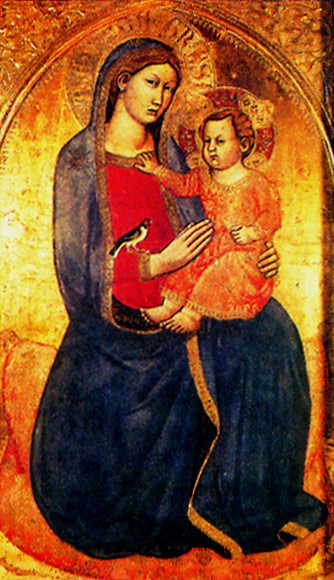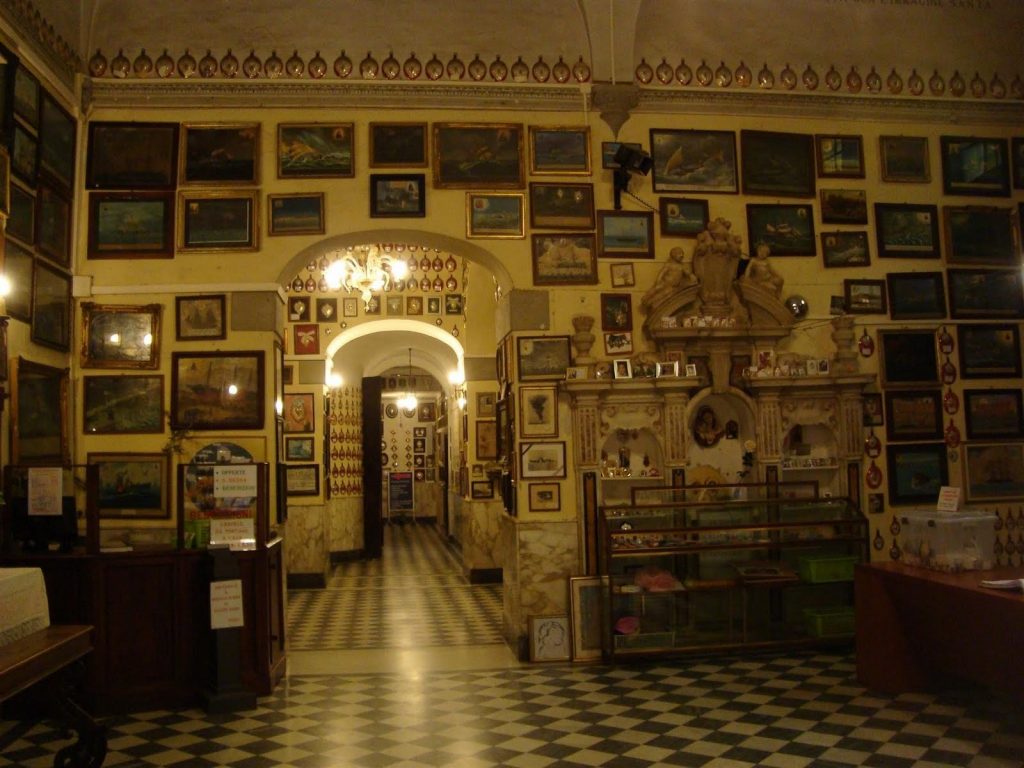
Il santuario della Madonna delle Grazie, assai più noto come santuario di Montenero, è posto sopra un colle in vista del mare e di Livorno. Ha origine da un’immagine di Maria, seduta su un guanciale di forma antica, a fiori e monogrammi d’oro, coperta di rosso e di manto celeste, sorreggente sul ginocchio sinistro il Bambino Gesù, che con una mano tocca la Madre e con l’altra tiene un filo a cui è avvinto un uccellino riposante sul braccio destro di lei.
The Shrine of Our Lady of Grace, also known as Sanctuary of Montenero, is located on a hill with a view of the sea and Livorno. It originates from an image of Mary, seated on an ancient-shaped pillow, with flowers and gold monograms, covered in red and a celestial mantle, holding the Child Jesus on her left knee, who touches the Mother with one hand and with the other holds a thread to which a resting bird is tied on her right arm.
Secondo la tradizione, nel 1345 un pastore claudicante, trovando ai piedi del colle un dipinto raffigurante la Madonna, avrebbe avuto una visione grazie alla quale fu spinto a trasportare l’effigie sino in cima alla collina, dove arrivò guarito della sua malattia. Per ricordare l’episodio, all’inizio della strada che conduce al santuario fu realizzata la piccola cappella detta dell’Apparizione, risalente al 1603; questa fu ampliata nel 1723, danneggiata durante la seconda guerra mondiale e sostituita nel 1957 da una chiesa più grande.
La fama legata a quell’evento fu tanta che già sul finire del medesimo secolo i numerosi pellegrinaggi permisero l’ampliamento del primo oratorio, tenuto inizialmente dai frati terziari, poi dai gesuati (XV – XVII secolo), e quindi dai teatini (XVII – XVIII secolo). Con la soppressione degli ordini religiosi voluta da Pietro Leopoldo, il santuario cadde in rovina, fino a quando, subentrato al potere Ferdinando III, non fu affidato alla custodia dei monaci vallombrosani (1792), che apportarono alcuni restauri.
According to tradition, in 1345 a lame shepherd, finding a painting depicting the Madonna at the foot of the hill, would have had a vision thanks to which he was pushed to carry the effigy up to the top of the hill, where he arrived cured of his illness. To commemorate the episode, a small chapel called the Apparition, dating back to 1603, was built at the beginning of the road leading to the sanctuary; this was enlarged in 1723, damaged during the Second World War and replaced in 1957 by a larger church. The fame linked to that event was so great that already at the end of the same century the numerous pilgrimages allowed the expansion of the first oratory, initially held by the tertiary friars, then by the Jesuits (XV – XVII century), and then by the Theatines (XVII – XVIII century). With the suppression of religious orders by Pietro Leopoldo, the sanctuary fell into disrepair, until, when Ferdinand III took over power, it was entrusted to the custody of the Vallombrosan monks (1792), who carried out some restorations.
Il 15 maggio 1947 la Madonna di Montenero è stata dichiarate Mater Etruriae (patrona della Toscana) da papa Pio XII. Da allora il 15 maggio pellegrini da tutte le diocesi toscane si radunano al santuario della Madonna delle Grazie per donare l’olio santo.
Lungo i fianchi della chiesa si snoda la galleria degli ex voto, tra le più ricche d’Italia e contenente circa 700 raffigurazioni realizzate tra l’Ottocento ed i giorni nostri. Tra gli spaccati di vita popolare di un tempo, si possono ammirare anche le tavole di Giovanni Fattori e Renato Natali.
L’accesso al Santuario, oltre che dalla strada, è garantito dalla caratteristica funicolare.
On may 15, 1947, the Madonna of Montenero was declared Mater Etruriae (patroness of Tuscany) by Pope Pius XII. Since then, on May 15, pilgrims from all the Tuscan dioceses gather at the sanctuary of the Madonna delle Grazie to donate the holy oil. Along the sides of the church there is the gallery of ex-votos, one of the richest in Italy and containing about 700 representations made between the nineteenth century and the present day. Among the glimpses of popular life of the past, you can also admire the tables by Giovanni Fattori and Renato Natali. Access to the Sanctuary, as well as from the road, is guaranteed by the characteristic funicular.



